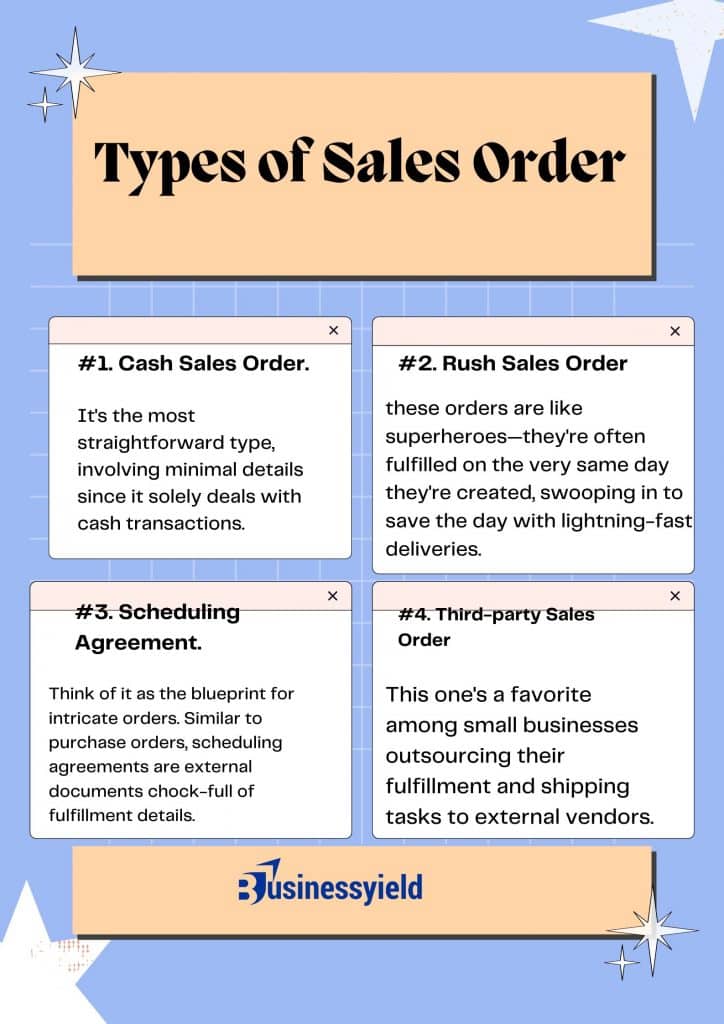Ever closed a deal and then felt a surge of excitement followed by a twinge of uncertainty? You’re not alone. While securing a sale is a victory, ensuring a smooth journey from “yes” to “delivered” requires a crucial next step: the sales order. This document isn’t just paperwork; it’s a roadmap for fulfilling your customer’s needs and keeping your business on track.
But what exactly is a sales order, and how can you manage them effectively? I will break it down for you. In this guide, I’ll unveil the secrets of crafting clear and accurate sales orders, streamlining your order fulfillment process, and keeping your customers happy – all while boosting your efficiency and bottom line.
Key Points
- Think of a sales order as the blueprint for a successful transaction.
- Sales orders act like a historical record, tracking what’s coming in and what’s going out.
- Sales orders also play a crucial role in streamlining financial processes and maintaining accurate records.
- Sales order management encompasses a broader spectrum of activities, capturing every facet of processing a sales order.
Understanding Sales Order
So, imagine this: You’re running a business, and every day, you’re flooded with orders from customers eager to get their hands on your awesome products. But how do you keep track of all these orders and make sure everything runs smoothly? That’s where sales orders come in.
Think of a sales order as the blueprint for a successful transaction. It’s the document that kicks off the entire sales process, detailing what the customer wants, how much they’re willing to pay, and when they expect to receive it. In essence, it’s the roadmap that guides businesses from order placement to delivery.
Check out this article on ORDER MANAGEMENT: Definition and Top Software Options
Alright, I whipped up a sales order! It’s like a formal confirmation after we agreed on everything. Let me break it down for you.
See it as a contract between us. I listed your name and contact details, so we both know who’s getting what. I also included mine, you know, just in case you need to get in touch.
Next up, the star of the show: the products or services you ordered. I made sure to detail everything, from the specific descriptions down to the quantities. That way, there are no surprises when it arrives.
Speaking of arrival, I threw in the shipping information too. It’ll show where your goodies are headed and give you an idea of when they’ll get there.
Now, the numbers. I listed the price for each item, nice and clear. Then I factored in any taxes or delivery fees, so you have a complete picture of the final cost.
But wait, there’s more! To make things smooth, I included the payment terms. It lays out exactly how and when you need to settle the bill.
And lastly, I threw in some terms and conditions, the fine print. It covers things like returns and warranties, just in case anything unexpected pops up.
So there you have it, the sales order! It’s a record of our agreement, ensuring we’re both on the same page. In this article, we’re going to go deep into the world of sales orders. You’ll understand what they are, why they’re important, and most importantly, how you can manage them like a pro. Whether you’re a seasoned entrepreneur or just dipping your toes into the world of business, mastering the art of sales order management is key to staying ahead of the game.
Let’s get started, shall we?
Benefits of Sales Orders
Let me tell you, sales orders are the unsung heroes of my business. They might seem like a formality, just another piece of paper in the whirlwind of transactions, but trust me, they’re the secret sauce to keeping things running smoothly. They’ve saved me countless headaches, and I want to share why they should be your secret weapon too.
#1. Boost the Tracking of Inventory
Sales orders are like a crystal ball for my inventory. Imagine this: a customer calls, eager to get their hands on that new gadget we just launched. With a sales order in place, I can instantly see how many gadgets we have in stock. No more scrambling around the warehouse, frantically counting boxes. The sales order tells me exactly what I need to know, allowing me to confirm availability confidently and set realistic delivery expectations.
But the benefits go beyond a simple stock check. Sales orders act like a historical record, tracking what’s coming in and what’s going out. This lets me see trends in demand. Are certain gadgets flying off the shelves, while others gather dust? The sales order data tells the story. Armed with this knowledge, I can optimize my inventory management. I can avoid overstocking on slow movers, freeing up valuable storage space and cash flow. Conversely, I can ensure I have enough of the hot sellers to meet customer demand and avoid stockouts that could damage my reputation.
#2. Organizes Your Accounts
Sales orders also keep my accounts department singing. They’re the missing puzzle piece that ensures everything is crystal clear. Each order details the exact products or services being sold, their quantities, and the agreed-upon price. This eliminates any confusion when it comes to invoicing. No more chasing down customers for clarification on what they ordered or how much they owe.
Plus, the sales order provides a single source of truth, streamlining the billing process and saving everyone involved a lot of time and frustration. Sales orders also play a crucial role in streamlining financial processes and maintaining accurate records. When I generate a sales order, it serves as a formal document that outlines the terms of the sale, including pricing, quantities, and payment terms.
This documentation not only provides clarity for both the customer and my accounting team but also serves as a reference point for invoicing and revenue recognition. By keeping meticulous records of sales orders, I can easily reconcile transactions, track payments, and ensure compliance with financial regulations.
#3. Lower the Chance of Human Error
In a fast-paced business environment, mistakes can happen, but sales orders act as a safeguard against costly errors. By standardizing the order entry process, I can minimize the likelihood of data entry mistakes or miscommunications. Each sales order contains detailed information about the customer’s requirements, reducing ambiguity and ensuring that orders are processed accurately. Furthermore, by automating certain aspects of the order fulfillment process, such as inventory allocation and invoicing, I can further mitigate the risk of human error and improve overall efficiency.
In addition, it minimizes the risk of errors creeping into my financial records. Remember those frantic stock checks I mentioned earlier? Without a sales order, there’s a chance I might miscount or forget to update the inventory system. But with a sales order in place, the information is captured accurately right from the start. This reduces the risk of discrepancies between what’s on the sales order, what’s actually in stock, and what shows up on the invoice. It might sound like a small detail, but trust me, these discrepancies can lead to major headaches down the line, especially during tax season. Sales orders keep everything nice and clean, allowing my accountant to work their magic with peace of mind.

Types of Sales Order
There are four distinct types, each serving different purposes and scenarios.
#1. Cash Sales Order.
It’s the most straightforward type, involving minimal details since it solely deals with cash transactions. Picture this: a customer places an order, pays for it right away, and boom, the order gets shipped. Alternatively, sometimes customers swing by to pick up their orders and settle the payment on the spot. Take, for instance, someone ordering a mattress online, and then dropping by the store to pay and collect the mattress themselves.
#2. Rush Sales Order
Sometimes things get a little more urgent. That’s where the rush order swoops in. This bad boy is for customers who need their stuff lightning fast. We’re talking about situations where the usual fulfillment time just won’t cut it. So, what’s the catch? Unlike cash orders, payment comes after the order is fulfilled. But the key thing is speed. And let me tell you, these orders are like superheroes—they’re often fulfilled on the very same day they’re created, swooping in to save the day with lightning-fast deliveries.
#3. Scheduling Agreement.
Think of it as the blueprint for intricate orders. Similar to purchase orders, scheduling agreements are external documents chock-full of fulfillment details. They outline when an order will be delivered and specify quantities for each product sold. This type of order is the go-to for those complex, multi-component deals that need careful coordination.
#4. Third-party Sales Order
This one’s a favorite among small businesses outsourcing their fulfillment and shipping tasks to external vendors. Once the order is created, it’s handed over to the third-party vendor, who then takes charge of fulfilling it. It’s like delegating the heavy lifting to someone else while you focus on other aspects of your business.
Read also: HOW TO START A DROPSHIPPING BUSINESS: Step-By-Step Beginners Guide
BusinessYield Sales Order Template
Sales Order Management
Sales order management is essentially the backbone of a company’s operations, encompassing a series of crucial actions from the moment a customer expresses interest in purchasing a product or service until the moment that item is securely delivered into their hands. It’s not just a single department’s responsibility; rather, it’s a holistic process that involves multiple teams and functions within the company.
At its core, sales order management diverges from mere order management, the latter of which primarily deals with overseeing orders that customers initiate themselves. Sales order management, however, encompasses a broader spectrum of activities, capturing every facet of processing a sales order. This includes everything from the initial interaction with the customer to the final delivery of the product or service.
When a customer places an order, it marks the initiation of the sales order management process. From here, it’s the responsibility of the sales team to navigate through various steps to ensure the order’s successful completion. Unlike standard order management, which might begin and end with the customer’s action, sales order management demands additional layers of attention and action. This is because the sales team must finalize the deals before the fulfillment team can proceed with the delivery process.
To illustrate, imagine a scenario where a customer expresses interest in purchasing a product. The sales team springs into action, initiating discussions, negotiating terms, and finalizing the sale. Once the deal is sealed, the sales order management process kicks into high gear. This involves documenting the order details accurately, verifying inventory availability, generating invoices, and coordinating with other departments to ensure seamless execution.
Each step in the sales order management process is interconnected, forming a cohesive chain that stretches from sales processes to fulfillment and delivery. Communication between teams is paramount to avoid bottlenecks or errors that could derail the entire process. The sales team must relay accurate information to the fulfillment team to ensure they can fulfill orders promptly and efficiently.
In essence, sales order management is the lifeline of any business that deals with selling products or services. It’s a dynamic process that demands meticulous attention to detail, effective communication, and seamless collaboration across departments. By mastering sales order management, companies can not only streamline their operations but also elevate the customer experience and drive sustainable growth in the long run.
Sales Order vs Purchase Order
Sales orders and purchase orders are critical documents in the world of commerce, forming the backbone of agreements between buyers and sellers. Though they share similarities, each serves distinct roles within the sales process, playing pivotal roles in facilitating transactions.
Let’s break down the difference between sales orders and purchase orders. These documents might seem like twins, but trust me, they each play a specific role in the whole buying and selling dance.
Imagine you’re running a bakery. A customer calls in wanting a custom cake – that’s their way of saying, “Hey, I need something from you.” But before you whip up that masterpiece, you need to get everything straight. So, you create a sales order. This is your official document outlining all the details: the kind of cake, how many layers, what kind of frosting, the price, when it needs to be ready, and how they’ll pay for it.
Now, that customer placing the order – that’s where the purchase order comes in. Think of it as their official request to you. It’s them saying, “This is exactly what I want, and I agree to your terms.” They’ll send this purchase order to you with all the same info you put in your sales order, just to make sure everything lines up perfectly.
In a perfect world, everything would match up right away, and you’d be off to baking that incredible cake. But sometimes, things need a little negotiation, especially with bigger companies. Maybe they want a discount for a bulk order, or perhaps they have a specific delivery window they need to meet. That’s when the back-and-forth starts, and sometimes, you might even need a third party to help smooth things over.
The key thing here is that once you and the customer agree on everything in the sales order, that becomes the official contract. It stops any future price changes or arguments about what was promised. It’s like a handshake – a clear sign that both parties are on the same page. This smooth transaction not only gets you that current sale but also paves the way for future business. After all, who wants to work with someone who keeps changing the rules?
Now, for smaller businesses, this process might be pretty straightforward. You place an order, you get what you ordered. But for larger corporations, it can get a bit more complex. Think of it like building a house – you wouldn’t just jump in and start hammering without a blueprint, right? The same goes for big business purchases. There might be detailed contracts involved, with lawyers scrutinizing every word to make sure everything is covered.
So, in essence, sales orders and purchase orders are more than just pieces of paper; they’re the building blocks of successful business relationships. By laying out the terms of the deal in clear, concise language, they ensure that transactions proceed smoothly and efficiently, paving the way for continued growth and prosperity for all involved.
What Is the Difference Between a Quotation and a Sales Order?
Imagine you’re running a shop. A quote is like a preliminary price list you give a customer. It’s an estimate of how much things would cost, including discounts and how long it’ll take to get everything ready. Think of it as a ballpark figure. A sales order, on the other hand, is a formal agreement. It locks in exactly what the customer is buying, the price they’ll pay, and when they’ll get it. So, a quote is like a draft, while a sales order is the final signed contract.
What Is the Purpose of a Sales Order?
A sales order serves as a crucial bridge between a seller and a customer. It’s like a formal handshake, sealing the deal. When a seller drafts up a sales order and sends it over to a customer, it’s like saying, “Hey, we’re on the same page, and here’s what we’ve agreed upon.” This document confirms the nitty-gritty details of the transaction – think quantity, pricing, and quality of goods or services. It’s a way to ensure clarity and transparency, making sure both parties are clear on what’s been bought and sold.
Why Do Companies Issue the Sales Orders?
So, companies whip up sales orders for a couple of key reasons. Think of it as a way to dot the i’s and cross the t’s before the goods or services even hit the road. See, before anything gets shipped out or delivered, companies want to make sure everyone’s on the same page. That’s where the sales order swoops in – it’s like a formal nod from the customer saying, “Yep, we’re good to go.” Plus, it helps streamline the whole process. Once a sales order is accepted, it sets the stage for the customer to fire off a purchase order, locking in the deal.
Conclusion
And that’s the beauty of a sales order! It provides you, the customer, with a clear picture of what you’re getting, when you’ll get it, and for how much. It also serves as a reference point if you have any questions down the line. So next time you place an order, remember – the sales order is there to ensure a smooth and satisfying transaction for both of us.
- Streamlining Business Operations: Unlocking Growth through Efficient Order Fulfillment
- Ten Ways Effective Data Management Can Boost Your Productivity
- FULFILLMENT CENTER: Meaning And Its Benefit To Small Businesses
- BEST INVENTORY MANAGEMENT COMPANIES: Top 10 Inventory Management Companies[2023 Update]






